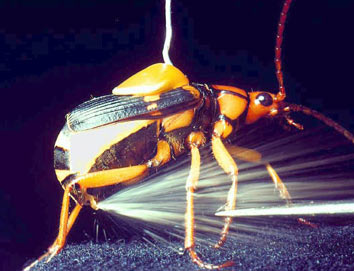First of all, the physiological mechanics will be tough. I've always felt the most plausible way to get the job done would be as shown in the illustration above, from the movie "Reign of Fire". Mixing of two biologically inert substances should create instant fire a safe distance from the dragon, with minimal risk to the dragon from storing the two reactants. Such hypergolic reactions I am presuming will be safer to living things than would be something pyrophoric (igniting upon contact with air), although the latter might be a simpler organismal engineering problem. Going with a hypergolic dragon's breath, there are already good animals to start from, like spitting cobras.
From here one would need to identify the developmental genes related to fang structure and play around with them until you had a beast with fangs that would, across generations, reproducibly cross the venom stream in front of its face. Presumably one might be able to engineer left/right asymmetry in the venom pits such that one produces only your hydrocarbon fuel (ethanol, isoprene, pristane, and squalene are all good candidates) and the other produces a sufficiently strong oxidizer to instantaneously produce flame upon mixing with the fuel.
So, how to play around with the venom sacs? This will be tough as you will also need to introduce left-right tissue differentiation. In fact it might be the toughest part of this chimeric invention. I started off by trying to think of examples in nature of animals with asymmetrical organs. Hearts don't really count because they are actually bilateral, but just squished to one side, and besides, what I'm really after is an organ that performs completely different biochemistry on the left than what it does on the right, so all the other major organs are out too, the pancreas, liver, gall bladder, etc. Even the intestines and appendix are all still technically bilateral. I started investigating the developmental genetic regulation behind the asymmetry of lobsters and fiddler crabs, and interestingly found that whichever claw they exercise more in their youth becomes the crusher, and the default becomes the cutter (fun fact, if they are deprived of exercise entirely, they become symmetrical cutters). There is surely genetic regulation going on underneath that process, with induction most likely by proprioceptive signalling molecules, so that might be the way to tweak this, but I'm unsure how neatly this would link up to a pathway which enables the dramatic differences in biochemistry I want to see in each venom pit. Let's just assume for now that we're going to hi-jack developmental pathways from lobsters to get the left/right differentiation, until I think of something better.
Next we'll need to come up with the specific biochemistry in each venom sack. I already invoked a hydrocarbon/oxidizer mix, and there are already very good pathways in birds for synthesizing and storing combustible squalene and pristane, so it should be a snap to get that working in snakes. It might be best to tweak this such that isoprene is the stored hydrocarbon, both for its greater volatility and for its lower combustion point. The venom pit holding our strong oxidizer will be more tricky. This is where my chemistry breaks down a little because I'm not sure if strong oxidizers like hydrogen peroxide or dinitrogen tetroxide are hypergolic with hydrocarbons like isoprene. Fortunately there is an entire field of chemists dedicated to the study of "green" rocket propellants. Although scant on specific details, this article implies that you can make a hydrocarbon (like kerosine) hypergolic with 90% H2O2 by mixing in some transition metals. I'll look into it a little more but if this is not true I'll need to think of a biologically plausible way to make and store hydrazine in the fuel-storing venom pit. For now I will assume that a metal-isoprene conjugate of some kind is hypergolic when mixed with 90% hydrogen peroxide (H2O2) and go on to ways of making and storing this oxidizer in the other venom pit. This then brings me to the amazing Bombardier Beetle.
From the wiki - "In the mixing chamber the enzymes rapidly break down the hydrogen peroxide, releasing free oxygen, and catalyze the oxidation of the hydroquinones into p-quinones. The reaction is very exothermic, and the released energy raises the temperature of the mixture to near 100 C, vaporizing about a fifth of it." How awesome is that?! Give up? OK I'll tell you, its more awesome than defending an orphanage from the empire of Xerxes the second with a fleet of armored Apaches flown by T. Rex pilots on July 4th, 1776.
Let's get back on track though. So we can import hydrogen peroxide biosynthesis and storage from beetle butts. Apparently the H2O2 stored inside these beetles is impressively concentrated to 25%, but that's unfortunately still a very long way off from 90%. We might require a few rounds of selective breeding here to get a stable line boosting that number up because otherwise our reaction won't be instantaneous, and we'll have mini-dragons slithering around spitting on people and then waiting around for a few minutes before they ignite. Fearsome mythological beasts have no time for that.
For now though I think we have our rough hypothetical framework for the fire-breathing part of our dragon. Since this was far more effort than I expected, I'll save the bits about flying and gold hoarding for a later post I think.


